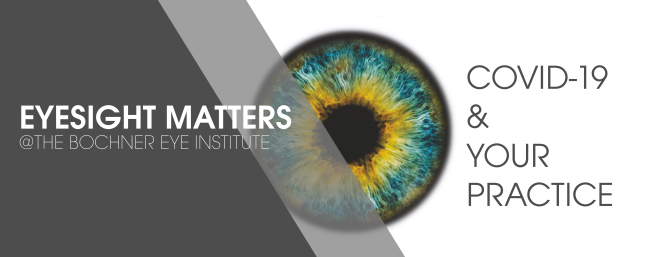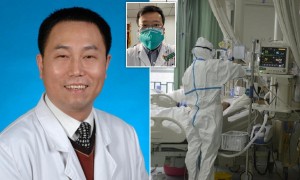
 The COVID 19 pandemic has forever changed the way we practice ophthalmology and optometry. This pandemic has impacted everyone in some way. Life as we know it, particularly for doctors, will never be the same. All of the essential service workers, doctors and nurses, and pharmacists on the frontline taking care of our friends and loved ones are modern day superheroes.
The COVID 19 pandemic has forever changed the way we practice ophthalmology and optometry. This pandemic has impacted everyone in some way. Life as we know it, particularly for doctors, will never be the same. All of the essential service workers, doctors and nurses, and pharmacists on the frontline taking care of our friends and loved ones are modern day superheroes.
This virus now known as Severe Acute Respiratory Syndrome Coronavirus 2 or
SARS-CoV-2 was declared a pandemic by the World Health Organization in March 2020. As the number of new cases and deaths start to decline, direction from Federal and Provincial governments and College bodies will allow practices to reopen. Until a vaccination is developed, ophthalmologists and optometrists will have to adapt to a new way of clinical practice.
Experts from the American Academy of Ophthalmology, John Hopkins School of Medicine, the World Health Organization, and the European Respiratory Society have all contributed to this blog to share suggestions for reopening practices. The goal is to disseminate practical and factual information which will assist eye doctors reopening their practices safely and responsibly. It is the expertise of our colleagues trained in systemic infectious diseases who will assist us in this new phase of reopening our practices.
Each doctor will need to make decisions and considerations for patient care until regulatory bodies determine best practices and standard of care. We are all on this journey together and sharing information and support is of the utmost importance.
Best wishes
The Ophthalmologist That Sounded the Alarm
 The ophthalmologist Dr. Li Wenliang, who was working in Wuhan Central Hospital, China, was one of the first people to recognize the outbreak of COVID-19 in late 2019. After he observed seven suspicious cases of patients with severe acute respiratory syndrome (SARS)-like symptoms, he sounded the alarm of a possible epidemic of a new virus, but was accused of making false alerts that disturbed the public order. It is not clear who else recognized the accumulating cases with suspicious symptoms and it is likely that other specialists besides the ophthalmologist realized the start of an infectious disease outbreak. By now, the whole world knows about the highly contagious virus SARS-CoV-2 which has rapidly emerged as a global health threat.
The ophthalmologist Dr. Li Wenliang, who was working in Wuhan Central Hospital, China, was one of the first people to recognize the outbreak of COVID-19 in late 2019. After he observed seven suspicious cases of patients with severe acute respiratory syndrome (SARS)-like symptoms, he sounded the alarm of a possible epidemic of a new virus, but was accused of making false alerts that disturbed the public order. It is not clear who else recognized the accumulating cases with suspicious symptoms and it is likely that other specialists besides the ophthalmologist realized the start of an infectious disease outbreak. By now, the whole world knows about the highly contagious virus SARS-CoV-2 which has rapidly emerged as a global health threat.
Dr Li Wenliang was later infected by SARS-CoV-2 from an asymptomatic glaucoma patient and died on February 7, 2020, at the age of 33. Ironically, it was an ophthalmologist who alerted officials, though complications of the eye are not considered key symptoms of COVID-19.
Bacherini D, Biagini I, Lenzetti C, Virgili G, Rizzo S, Giansanti F. The COVID-19 pandemic from an ophthalmologist’s perspective. Trends in Molecular Medicine. 2020 Apr 6.
Asymptomatic Carriers of the Virus
- Asymptomatic carriers may be the major way that the virus spreads in the population. A recent report in four US state prisons revealed that nearly 3,300 inmates tested positive for the coronavirus with 96% asymptomatic.
- An asymptomatic carrier can transmit the virus to others, which can result in disease, especially those most vulnerable. As clinicians, we need to assume that all our patients are carriers and take the necessary precautions.
Asymptomatic Carriers – View Article
General Ophthalmic & Optometric Office Suggestions
- Consider wearing a disposable gown in the office and/or scrubs. If you wear scrubs, change back to your regular clothes at the end of the office day or remove your scrubs immediately when you arrive home.
- Protecting your mouth, nose (e.g. an N95 mask) and eyes (e.g. goggles or shield) is recommended.
- Disposable gloves should be worn for those involved with direct patient care.
- A protective barrier at the front desk is an option. Receptionists should wear protective equipment, which may consist of masks, face shields, and/or googles.
- Appointments should be scheduled to reduce the number of patients waiting in the office.
- Restrict the office to patients only, unless they require assistance.
- Patients should notify the office by phone when they arrive, and only be allowed in when they are about to be seen. Patients that come by car can wait in their vehicle.
- Patients should be encouraged to wear a mask or a covering over their mouth and nose. If they do not have a covering on arrival, then a mask should be provided.
- Temperature screening of patients can be performed with a non-contact device.Those with an elevated temperature should not be permitted access. A telephone conversation or telemedicine consult can determine the next steps in patient care.
- Patients should be asked to use a disinfectant on their hands on arrival.
- Waiting rooms should be designed that follow social distancing guidelines. Eliminate high risk surfaces such as magazines.
- A slitlamp breath shield should be in place.
- A disposable eye occluder is preferred such as tissue paper held by the patient.
- Consideration can be given to protected screens for testing equipment like autorefractors, phoropters, colour photography units, and OCTs.
- Pneumotonometers can potentially result in aerosol of the virus. Disposable tipped contact devices are preferred for measuring pressure such as a tonopen.
- For routine office visits in asymptomatic patients, consideration can be given to wide-field fundus imaging without dilation to minimize the patient’s time in the office.
- If dilating drops are given, to consider disposable minims to reduce the risk of bottle contamination.
- Slitlamps, table tops, exam chairs, waiting room chairs, door knobs, and other surfaces need to be wiped down after each patient. Restrooms need to be cleaned frequently.
- To minimize face-to-face time in the office and hence exposure, consideration can be given to the use of phone calls or telemedicine. This may be appropriate for triage, the consultation itself, management, and counselling. Videoconferencing is becoming popular with a number of providers such as Zoom.us and Doxy.me.
- Post practice signs and instructions such as:
What To Do If You Are Sick (PDF)
Stay Home When You Are Sick (PDF)
Protective Equipment Sources
- A search of Canadian companies that distribute personal protective equipment is provided here courtesy of the Bochner Eye Institute.
- The quality and delivery times have not been verified. There are other companies that also provide these items.
- The Bochner Eye Institute has no financial interest in any of these companies, nor have these companies paid to be on this blog.
- Click on the links for further information:
Slitlamp Breath Shields
Facial Shields
Acrylic Protection for Receptionists
Shield for Indirect Ophthalmoscopes
American Academy of Ophthalmology
Conjunctivitis Secondary to Coronavirus
- SARS-CoV-2 can cause a mild follicular conjunctivitis otherwise indistinguishable from other viral causes, and possibly be transmitted by aerosol contact with conjunctiva. However, at this point in the COVID-19 pandemic, practically any patient seen by an eye doctor could be infected with SARS-CoV-2, regardless of presenting diagnosis, risk factors, or indication for visit
- Existing data suggest that conjunctivitis is an uncommon event as it relates to COVID-19. However, because conjunctivitis is a common condition overall, and patients with conjunctivitis frequently present to eye clinics or emergency departments, it may happen that eye doctors are the first providers to evaluate patients possibly infected with COVID-19. A patient with COVID-19 associated conjunctivitis could have infectious virus in their ocular secretions.
Disinfectants
- SARS-CoV-2 is susceptible to the same alcohol- and bleach-based disinfectants that eye doctors commonly use to disinfect ophthalmic instruments and office furniture. To prevent SARS-CoV-2 transmission, the same disinfection practices already used to prevent office-based spread of other viral pathogens are recommended before and after every patient encounter.
Environmental Contamination
- Environmental contamination by SARS-CoV-2 is another cause for concern. In a study published in the New England Journal of Medicine, scientists were able to detect viable SAR-CoV-2 in aerosols up to 3 hours post-aerosolization, although in an experimental setup lacking any ventilation, and not necessarily reflecting how the virus behaves in real-life conditions.
- The study also found infectious virus could survive up to 24 hours on cardboard, up to 4 hours on copper, and up to 2 to 3 days on plastic and stainless steel.
- In another study by the CDC of the recent cruise ship outbreaks of COVID-19, SARS-CoV-2 RNA (not necessarily indicating infectious virus) was identified on various surfaces within cabins of passengers who tested positive, for up to 17 days after they disembarked the ship.
Treatment and vaccine
- Currently, there are no proven agents for prophylaxis or therapy for SARS-CoV-2 infection.
- Remdesivir, an investigational antiviral drug, has shown promise in a recently published compassionate use study.
- Monoclonal antibody IL-6 receptor antagonists are being studied to address the “cytokine storm” seen in some patients with severe COVID-19.
- There are also efforts to use convalescent sera from COVID-19 survivors as therapy.
- More information about developments in the treatment of COVID-19 by these agents is available from the CDC.
John Hopkins School of Medicine
How long does it take to develop symptoms after you have been exposed to COVID-19?
- Symptoms could appear as soon as two days after exposure or as long as 14 days later, according to the Centers for Disease Control and Prevention (CDC).
- A new study led by researchers at the Johns Hopkins Bloomberg School of Public Health shows that the median time for symptoms to show up is about five days. That is why the CDC uses the 14-day quarantine period for people with likely exposure to the new coronavirus.
World Health Organization
Are hand dryers effective in killing the new coronavirus?
- No. Hand dryers are not effective in killing the 2019-nCoV. To protect yourself against the new coronavirus, you should frequently clean your hands with an alcohol-based hand rub or wash them with soap and water. Once your hands are cleaned, you should dry them thoroughly by using paper towels or a warm air dryer.
Can an ultraviolet disinfection lamp kill the new coronavirus?
- UV lamps should not be used to sterilize hands or other areas of skin as UV radiation can cause skin irritation.
European Respiratory Society
Sudden loss of taste and smell should be part of COVID-19 screen
- A number of new publications show a high proportion of people infected with COVID-19 report loss of smell and/or taste, and these symptoms should be recognised as potentially indicative of the infection. In particular, there is a belief that these signs may be present in many with asymptomatic COVID-19, and therefore asking about them could be a way to prioritise people for initial testing for the SARS-CoV-2 virus in the absence of other symptoms.
- WHO and Centers for Disease Control and Prevention have now added “new loss of taste or smell” as a symptom on its COVID-19 information page.
Loss of Taste &/or Smell – Editorial
Loss of Taste &/or Smell – Article
